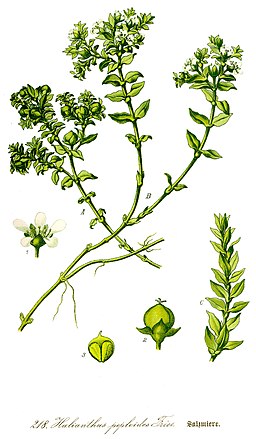|
|
|
|
|
|
| Practical ecological knowledge for the temperate reader. |
Seabeach Sandwort - Honckenya peploides
Family: Pink - Caryophyllaceae Family
Other Names: seaside sandplant[E-flora]
 [Wiki]
[Wiki]
SUBTAXA PRESENT IN BC
- Honckenya peploides ssp. major [E-flora]
"Honckenya peploides is a PERENNIAL growing to 0.2 m (0ft 8in) by 1 m (3ft 3in) at a medium rate.
It is hardy to zone (UK) 5 and is not frost tender. It is in flower from May to August, and the seeds ripen from Jul to September. The flowers are hermaphrodite (have both male and female organs) and are pollinated by Insects, wind, wind-blown sand, self.The plant is self-fertile.
Suitable for: light (sandy) and medium (loamy) soils, prefers well-drained soil and can grow in nutritionally poor soil. Suitable pH: acid, neutral and basic (alkaline) soils. It cannot grow in the shade. It prefers dry or moist soil. The plant can tolerate maritime exposure." [PFAF]
General:
"Succulent perennial herb from a deep taproot and slender rhizomes; forming mats to 80 cm across or more; stems numerous, trailing, usually freely branching, glabrous, flowering stems prostrate to erect, 5-40 cm tall/long." [IFBC-E-flora]
Leaves:
"Basal leaves lacking; stem leaves opposite, 3-10 pairs or more, from lanceolate to egg-shaped, sharp-pointed to obtuse, 1-4 cm long, 3-20 mm wide, fleshy, yellowish-green, glabrous, often with sterile axillary shoots; stipules lacking." [IFBC-E-flora]
Flowers:
"Inflorescence of solitary or a few flowers in the upper leaf axils, perfect or unisexual; petals 5, greenish-white, egg-shaped, 2-3 mm long; sepals 5, egg-shaped to lanceolate, 4-7 mm long, glabrous." [IFBC-E-flora]
Fruits:
"Capsules globose or nearly so, 6-10 mm long, 3- to 5-valved; seeds chestnut brown, 3-4.5 mm long, smooth." [IFBC-E-flora]
Habitat / Range
Moist sandy beaches and grassy shorelines in the lowland zone; common along the coast; N to AK, YT and NT and S to NW OR. [IFBC-E-flora]
Origin Status:
Native [E-flora]
Edible Uses
Honckenya peploides major Beach Greens, Seabeach - spring & summer - Leaves, stems consumed by Alaskan eskimos. Also stored. [Helaine_Selin] Aerial parts consumed in Sweden [Tardio MWEP]
- Leaves & Shoots: Young leaves and shoots picked before the plants flower, and eaten fresh or preserved by fermenting in a cool place. Late spring to early summer. Wash well to remove sand. Lightly steamed, added to stir-fries, simmered in soups, pickled.[Schofield] Preserved by fermenting them by the barrelful. Cooked and let to "sour." Sometimes they are interspersed with layers of sea lovage leaves (Angelica lucida) or sourdock (Rumex articus),or blueberries or crowberries. They are eaten with seal oil and sugar, like sauerkraut, especially with fat fish. The Eskimo of Saint Lawrence Island and Shishmaref prepared the leaves in the same way, mixing them after souring with fat and berries to make "Eskimo ice cream," and eating them with dry fish.[Turner, Kuhnlein] With a little advance planning, spring-prime beach greens can be enjoyed year-round. Just collect a quantity before the plants flower, wash well, blanch one minute, and freeze in plastic bags. Besides being tasty (some writers liken the flavor to cabbage and watercress), they're extremely high in vitamin A as well as the scurvy-fighting C. [Schofield]
- Leaves; The raw, fresh leaves are reported to be a good source of vitamins C and A, and were brought by early Arctic explorers to cure scurvy.[Turner, Kuhnlein] Prime before flowering but often gathered into august.[Schofield] The leaves can also be fermented and used like sauerkraut[115, 257]. [PFAF]
- Seeds: Honkenya peploides; Tedious to collect. Ground and used to extend flour supply, or sprinkled as a garnish on various foods. Late summer.[Schofield] Used as a garnish or ground into a powder and added to flour[172]. Very fiddly to harvest[172]. [PFAF]
- Young Shoots: Honkenya peploides; Raw or cooked and used as a potherb[2, 61, 183]. A sour taste[257]. A delicious flavour, they are rich in vitamins A and C[172, 257]. They are at their best before the plant flowers[172]. [PFAF]
- Plant: Honkenya peploides; In Iceland the plant is steeped in sour whey and allowed to ferment. The resulting liquor is said to taste like olive oil and is used as a beverage[183]. [PFAF]
Medicinal Use
- According to one of John Aubrey’s correspondents in 1695, Honckenya
peploides was one of several antiscorbutic herbs gathered in the northern
parts of Orkney.66 [MPFT]
Nutritional Information
Seabeach-Sandwort – Arenaria peploides
Part: Leaves Per 100 g fresh weight
- Vitamin C (mg)42.5
- Vitamin A (RE)575
[Turner, Kuhnlein]
Cultivation
Requires a well-drained soil and an open sunny position. Plants are tolerant of short periods of immersion in salt water[17]. When well sited, the plant can spread quite freely at the roots[K]. Grows well in an outdoor bed at Kew[K].[PFAF]
Propagation
Seed - sow March in a cold frame. Prick out the seedlings into individual pots when they are large enough to handle and plant them out in the summer. Division in early spring. Very easy, larger clumps can be replanted direct into their permanent positions, though it is best to pot up smaller clumps and grow them on in a cold frame until they are rooting well. Plant them out in the spring.[PFAF]
Synonyms
- Arenaria peploides var. major Hook. [E-flora].
- Arenaria peploides var. maxima Fern. [E-flora].
- Honckenya oblongifolia Torr. & A. Gray [E-flora].[ThePlantlist.org] 2/3 Confidence 02/19/14
- Honckenya peploides var. major (Hook.) Abrams [E-flora]. [ThePlantlist.org] 1/3 Confidence 02/19/14
Honckenya Species
- Honckenya peploides - seabeach sandwort [E-flora]. [TSFTK][PCBC] - Misspelled in both as 'Honkenya' (This does not appear to be a different species)
References
Page last modified on Feb 10, 2024
 [Wiki]
[Wiki]